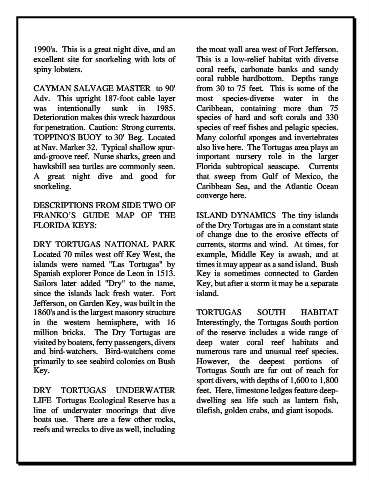Page 1317 - Dive the Seas and More-2
P. 1317
1990's. This is a great night dive, and an the moat wall area west of Fort Jefferson.
excellent site for snorkeling with lots of This is a low-relief habitat with diverse
spiny lobsters. coral reefs, carbonate banks and sandy
coral rubble hardbottom. Depths range
CAYMAN SALVAGE MASTER to 90' from 30 to 75 feet. This is some of the
Adv. This upright 187-foot cable layer most species-diverse water in the
was intentionally sunk in 1985. Caribbean, containing more than 75
Deterioration makes this wreck hazardous species of hard and soft corals and 330
for penetration. Caution: Strong currents. species of reef fishes and pelagic species.
TOPPINO'S BUOY to 30' Beg. Located Many colorful sponges and invertebrates
at Nav. Marker 32. Typical shallow spur- also live here. The Tortugas area plays an
and-groove reef. Nurse sharks, green and important nursery role in the larger
hawksbill sea turtles are commonly seen. Florida subtropical seascape. Currents
A great night dive and good for that sweep from Gulf of Mexico, the
snorkeling. Caribbean Sea, and the Atlantic Ocean
converge here.
DESCRIPTIONS FROM SIDE TWO OF
FRANKO’S GUIDE MAP OF THE ISLAND DYNAMICS The tiny islands
FLORIDA KEYS: of the Dry Tortugas are in a constant state
of change due to the erosive effects of
DRY TORTUGAS NATIONAL PARK currents, storms and wind. At times, for
Located 70 miles west off Key West, the example, Middle Key is awash, and at
islands were named "Las Tortugas" by times it may appear as a sand island. Bush
Spanish explorer Ponce de Leon in 1513. Key is sometimes connected to Garden
Sailors later added "Dry" to the name, Key, but after a storm it may be a separate
since the islands lack fresh water. Fort island.
Jefferson, on Garden Key, was built in the
1860's and is the largest masonry structure TORTUGAS SOUTH HABITAT
in the western hemisphere, with 16 Interestingly, the Tortugas South portion
million bricks. The Dry Tortugas are of the reserve includes a wide range of
visited by boaters, ferry passengers, divers deep water coral reef habitats and
and bird-watchers. Bird-watchers come numerous rare and unusual reef species.
primarily to see seabird colonies on Bush However, the deepest portions of
Key. Tortugas South are far out of reach for
sport divers, with depths of 1,600 to 1,800
DRY TORTUGAS UNDERWATER feet. Here, limestone ledges feature deep-
LIFE Tortugas Ecological Reserve has a dwelling sea life such as lantern fish,
line of underwater moorings that dive tilefish, golden crabs, and giant isopods.
boats use. There are a few other rocks,
reefs and wrecks to dive as well, including

